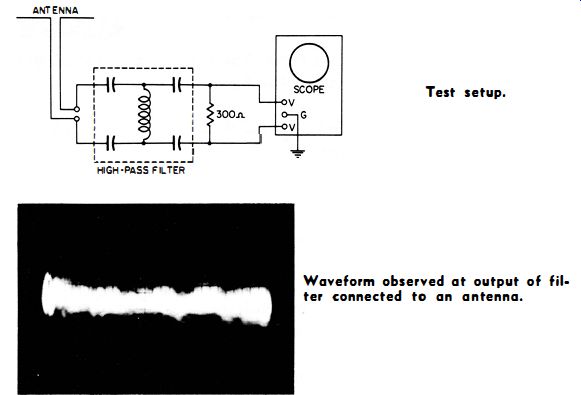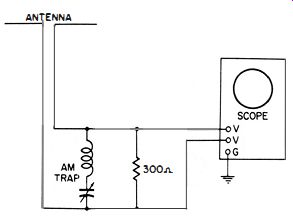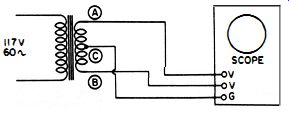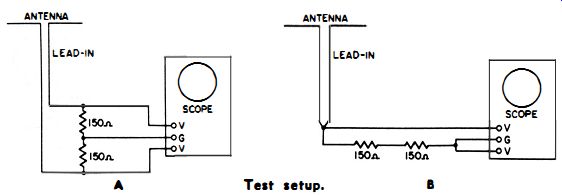To Measure the Peak-to-Peak Voltage of AM Broadcast and Short-Wave Signals Picked Up by a TV Antenna
Equipment: Calibrated wide-band scope with double-ended input and 300-ohm resistor.
Connections Required: Terminate the lead-in with the 300-ohm resistor and apply signal to the vertical-input terminals of the scope.
Procedure: Adjust scope controls for suitable pattern height.
Measure the peak-to-peak voltage of the maximum signal excursion.
Evaluation of Results: The signal voltage measured is the resultant of all signal voltages falling within the scope passband. This is the important measurement to be made when troubleshooting cross modulation of an RF tuner by AM broadcast signals. (Also see U14.)
------------

Test setup. Typical waveform observed at the output of the antenna.
+++++++
U14
To Check the Effectiveness of a High-Pass Filter in Eliminating AM Broadcast Interference from a TV Antenna
Equipment: High-pass filter; double-ended, wide-band scope; and 300-ohm resistor.
Connections Required: Connect lead-in to input terminals of high-pass filter. Terminate filter with 300-ohm resistor and apply filter output to vertical-input terminals of scope.
Evaluation of Results: Vertical deflection should be very small compared with deflection obtained without filter. Otherwise, filter is not operating satisfactorily.

------ Test setup. Waveform observed at output of filter connected to an antenna.
NOTE 22
Antenna Effect Causes Scope Interference When Field Strength Is High
When making tests with a coil connected across the vertical-input terminals of a wide-band scope, as shown in the following illustration, the base line will show rapidly changing modulation interference if working in an area of high AM broadcast field strength. The interference is greater when the scope is operated at high gain. The best remedy for this difficulty is to design the shop as a screen room (walls lined with grounded copper screening) _

--- Coil connected across scope vertical input.
Interference from AM broadcast stations.
+++++++++++
U15
To Measure the Rejection of AM Broadcast Interference From a TV Antenna, Using a Tuned Trap
Equipment: AM trap and 300-ohm resistor.
Connections Required: Connect trap across lead-in. Terminate lead-in with 300-ohm resistor. Apply signal to vertical-input terminals of scope, as shown in the following diagram.
Procedure: Adjust trap tuning to minimize AM interference.
Then disconnect trap and observe difference in vertical deflection.
Evaluation of Results: Rejection can be measured as a voltage ratio, but more advantageously as a decibel ratio. Decibels are proportional to eye and ear response. The relation between voltage ratios and decibels can be found in most standard handbooks.

----- Test setup.
NOTE 23
How to Calibrate a Double-Ended Scope
A double-ended scope can be calibrated by applying a known 60 cycle, sine-wave voltage between both vertical-input terminals. Or, to obtain the most accurate calibration, use a step-down transformer with a center-tapped secondary, as shown in the following. Connect a VOM or VTVM between A and C, and read the voltage. Then connect the meter between B and C, and read the voltage between these points. Add the two voltages. This sum is the calibrating voltage.

----- Method of calibrating double-ended scope.
+++++++++++++
U16
To Check a Lead-in for Electrical Balance (Rejection of Antenna Effect)
Equipment: Two 150-ohm resistors and a wide-band, double-ended scope.
Connections Required: Terminate lead-in with the two 150-ohm resistors series-connected. Connect to scope in first test as shown at A. Connect to scope in second test as shown at B.
Procedure: Note vertical deflections obtained in A and B. Scope may need to be operated at high gain, depending upon the prevailing AM broadcast field strength.
Evaluation of Results: The ratio of the two deflections is a measure of the electrical balance of the lead-in installation.

--------- Test setup.
+++